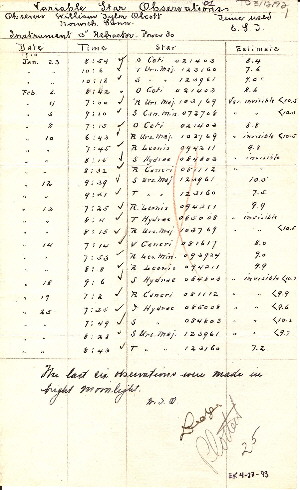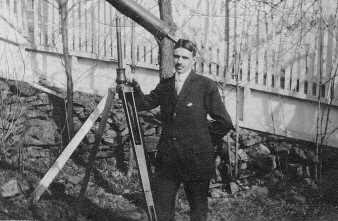First of a series celebrating 100 years of the AAVSO
The paper shown here is a list of variable star observations made in early 1910 by William Tyler Olcott of Norwich, Connecticut. Olcott was thirty-seven years old at the time. By itself, the sheet of observations is not very remarkable. After all, professional astronomers and experienced amateurs had been recording variable star observations for over sixty years; Professor Edward C. Pickering, Director of Harvard College Observatory, had been collecting variable star observations for about thirty years with the help of a small band of amateur and professional observers. By 1910, the discovery of a variable star was a routine, event—almost robotic—when hundreds were being discovered using photographic plates.
By itself, the sheet of observations is not very remarkable. After all, professional astronomers and experienced amateurs had been recording variable star observations for over sixty years; Professor Edward C. Pickering, Director of Harvard College Observatory, had been collecting variable star observations for about thirty years with the help of a small band of amateur and professional observers. By 1910, the discovery of a variable star was a routine, event—almost robotic—when hundreds were being discovered using photographic plates.
Olcott in 1910 was just one more amateur, indeed novice, astronomer, who volunteered to send his observations to Pickering at HCO.
In 1905, Olcott and his wife Clara had just built a summer cottage on Block Island, Rhode Island. He was twenty-nine years old that summer when a friend visiting the cottage, Helen McGregor Clarke, pointed-out the constellations and bright stars to him over several nights.
Olcott was enthralled with the stars from that point on. He made notes about what he learned, read many astronomy books, and bought a three-inch refractor. His interest and note-writing led to the publication in 1907 of The Field Book of the Stars; then In Starland With a Three-Inch Telescope in 1909. That same year he learned about variable stars at a meeting of the American Association for the Advancement of Science in Boston, where Professor Pickering said that amateur astronomers could make a difference by helping to collect variable star observations.
This, for Olcott was better than star-gazing, even better than being an author: he had the opportunity to actually become an observational astronomer in the service of science. He volunteered on the spot. Pickering sent his assistant, Leon Campbell, to Connecticut to teach Olcott how to observe variable stars. Just a few months later, Olcott sent his first report to Pickering at HCO. In Olcott's first report there are twenty-five observations of ten stars, almost half are "invisible" or fainter-thans. We see that he attempted to follow omi Cet as it declined in magnitude—but probably lost it due to weather conditions. We can see that, for a novice observer, Olcott was willing to challenge himself by trying to observe stars that were on the fainter side for the size of his instrument. We can also see that Olcott gradually added new stars to his list as he proceeded through the month. On most days, he seemed to be limited to just one observation, again probably due to mid-winter weather conditions; but there are five nights when he made three or more observations. And, as his first month of observing went on, he seemed to be going out earlier each night—out of enthusiasm and excitement, perhaps?
In Olcott's first report there are twenty-five observations of ten stars, almost half are "invisible" or fainter-thans. We see that he attempted to follow omi Cet as it declined in magnitude—but probably lost it due to weather conditions. We can see that, for a novice observer, Olcott was willing to challenge himself by trying to observe stars that were on the fainter side for the size of his instrument. We can also see that Olcott gradually added new stars to his list as he proceeded through the month. On most days, he seemed to be limited to just one observation, again probably due to mid-winter weather conditions; but there are five nights when he made three or more observations. And, as his first month of observing went on, he seemed to be going out earlier each night—out of enthusiasm and excitement, perhaps?
Olcott sent a report to Pickering each month from then on. By the end of his first year of observing he had doubled the number of observations and stars observed. He was in it for good.

